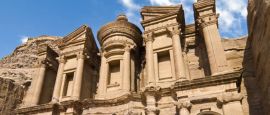Jordan Weather, climate and geography
Weather & climate
Jordan is a year-round destination. Even in high summer (June-August), Amman and most areas around the country are not excessively hot, chiefly due to the moderating influence of altitude – Amman stands around 850m (2800ft) above sea level. Similarly, Petra enjoys an elevated position – around 1,100m (3600ft) above sea level, so here, too, although days in summer can be hot, nights are often rather chilly. For Petra, as well as decent walking shoes – the only way in and out of the ruins is by a moderately testing walk over stony ground – also bring something warm for the evenings, even in summer. In winter, Petra can be very cold, with rain and even snow.
The Jordan Valley and the Red Sea coast around Aqaba is warm during winter (December-February) – a pleasant relief from the chill elsewhere – but extremely hot in summer (June-August). In the Eastern Desert, the winter can be bitterly cold and dry and the summer intensely hot. Some high-altitude areas, such as Ajloun, Dana and Petra, can receive snowfall in winter. Rain falls in many areas across the country on higher ground between October and March.
Do you have any Feedback about this page?
© Columbus Travel Media Ltd. All rights reserved. No part of this site may be reproduced without our written permission, click here for information on Columbus Content Solutions.
¿Tiene comentarios sobre esta página?
© Columbus Travel Media Ltd. All rights reserved. Ninguno de los contenidos de esta Web debe ser reproducido sin nuestra autorización expresa y escrita. Para más información sobre como obtener permiso para la utilización del contenido clica aquí. No part of this site may be reproduced without our written permission, click here for information on Columbus Content Solutions .
Avez-vous des commentairessur cette page?
© Columbus Travel Media Ltd. All rights reserved. Le contenu de ce site ne peut être reproduit sans autorisation écrite. Cliquez ici pour plus d'information sur notre 'des solutions de contenu’. No part of this site may be reproduced without our written permission, click here for information on Columbus Content Solutions.
Haben Sie Feedback zu dieser Seite?
© Columbus Travel Media Ltd. All rights reserved. Alle Inhalte dieser Seite sind urheberrechtlich geschützt und dürfen nur mit schriftlicher Genehmigung des Verlags genutzt werden. Weitere Informationen finden Sie in unseren Lizenzbestimmungen. No part of this site may be reproduced without our written permission, click here for information on Columbus Content Solutions .





 You know where
You know where